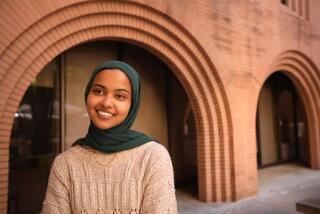California natives are staying put
A profound shift away from California’s more transient and migrant-dependent past will soon produce the state’s first generation of adults whose majority will be native-born, researchers at USC said in a study released Monday.
More than 70% of Californians ages 15 to 24 were born and raised in the state, according to the report, “The New Homegrown Majority in California.” By contrast, nearly two-thirds of state residents 45 to 54 years old were born out of state.
The change has far-reaching implications for everything from investment in the public education system to who will buy retiring baby boomers’ homes and shoulder the burden of future taxes, said Dowell Myers, one of the study’s principal authors.
“It’s a sea change in demography but also in political perceptions,” Myers said. “We’ve transformed from being a state of migrants to a settled state of native Californians.
“We’re basically becoming more self-reliant on who we have here. And we’re going to be prospering or suffering on who we have here.”
Significantly -- and in contrast to the past -- the emerging homegrown majority will have been shaped entirely by their life experience in California, notably their schooling, the report says.
“They are products of the school system, for better or for worse,” Myers said.
The younger generation of native-born Californians is more likely to support higher taxes for public services and to stick around to return the state’s investment in their education, the study said.
The recent trends, which cut across racial and ethnic groups, mark a reversal in losses of native-born Californians during the recession of the 1990s.
Among other things, the shift may reflect a more family-anchored culture among fast-growing Latino and Asian groups and a greater desire to remain rooted near relatives, the study suggests.
California natives now are more inclined to remain in their home state than residents of 45 other states, the report says.
Cultural ties may be one factor. But across the country today more people are staying put for a combination of reasons, said D’Vera Cohn, who has studied the trends for the Pew Research Center. An aging population, the complexity of moving families when both parents work and the recession all appear to play a role, she said.
Also, a recent Pew study found that after years of rapid growth, illegal immigration to California is slowing down. The state’s share of the nation’s estimated 11.9 million undocumented migrants has dropped to 22% from 42% in 1990, researchers found.
Most of California’s emerging homegrown majority of teens and young adults are citizens, researchers note. A sizable minority -- 14% of the state’s school age students, according to one Pew study -- are children of illegal immigrants.
Myers said the new findings suggest a social compact on public policy and investment between older and wealthier Californians and a more ethnically diverse younger generation. As those young adults move into the middle class, they will help support retirees and be customers for one of their largest assets: their homes.
“Older folks tend to think these [education services are] consumed by the young, for the benefit of the young,” he said. “If you think about it, there’s a lot in it for everyone.”
For example, young Latinos with college degrees pay on average 60% more for homes than Latinos with high school degrees, he said.
Still, intense debate over the cost of providing services to children of illegal immigrants and the fight over immigration reform affect how different groups interpret such studies, said Roberto Suro, a professor in USC’s Annenberg School of Communications.
“Simply as a practical political matter, it’s harder to get to [Myers’] larger issue until that one [immigration] is settled.”
But regardless of one’s political views, the study identifies “a transformative moment” for California, said Suro, who specializes in demographics. Luring educated, skilled labor from elsewhere was “what created California. . . . It’s sort of been the ace in the hole.”
The new research, he said, “means that the state has to generate its own human resources.”
--
--
(BEGIN TEXT OF INFOBOX)
70.5
Percent of California 15- to 24-year-olds, as of 2007, who were born and raised here
53.2
Percent as of 1990
50
Percent of Americans 25 and older who still lived in their state of birth in 2007
66.9
Percent of Californians 25 and older as of 2007 who were born in the state
--
Source: USC School of Policy, Planning and Development
More to Read
Start your day right
Sign up for Essential California for news, features and recommendations from the L.A. Times and beyond in your inbox six days a week.
You may occasionally receive promotional content from the Los Angeles Times.






